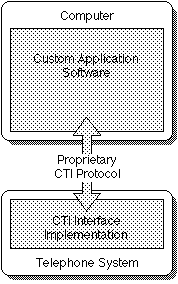First Phase of CTI Evolution Custom Systems | ||
| The first phase in the evolution of CTI involved custom development. Anyone who wanted to integrate a telephone system and a computer system had to work directly with the telephone system vendor to obtain that vendor's proprietary (and often product-specific) CTI interface. These CTI interfaces ranged from specifications for how a computer could be interfaced to the telephone system in question, to special APIs for specific operating systems. This is illustrated below. | |||||
 | ||||||
The economics of this arrangement were very poor. In most cases, customers themselves (or systems integrators working on behalf of customers) were developing vast quantities of highly specialized software that was hard-coded to a very specific telephone system. Rarely could this software be reused by others who had the same telephone system. Furthermore, should customers ever need to upgrade their telephone systems, they generally needed to rewrite their CTI software. In instances where telephone vendors had invested in some type of custom API, it invariably was on the wrong operating system for many customers, and was in any case only a slight improvement in the situation. The custom API still required that the customer develop software specialized to a very specific telephone system. In addition, the telephone system vendor had to keep track of all the popular operating systems. They had to split their development resources between maintaining existing custom API implementations (as new versions of supported operating systems were released), and trying to develop or adapt ("port") the API for new operating systems as they appeared. Both of these arrangements severely limited the potential size of the CTI industry for a very long time. | ||||||
© Copyright 1996-2004 For more information, contact Michael Bayer at Computer Telephony Solutions | |